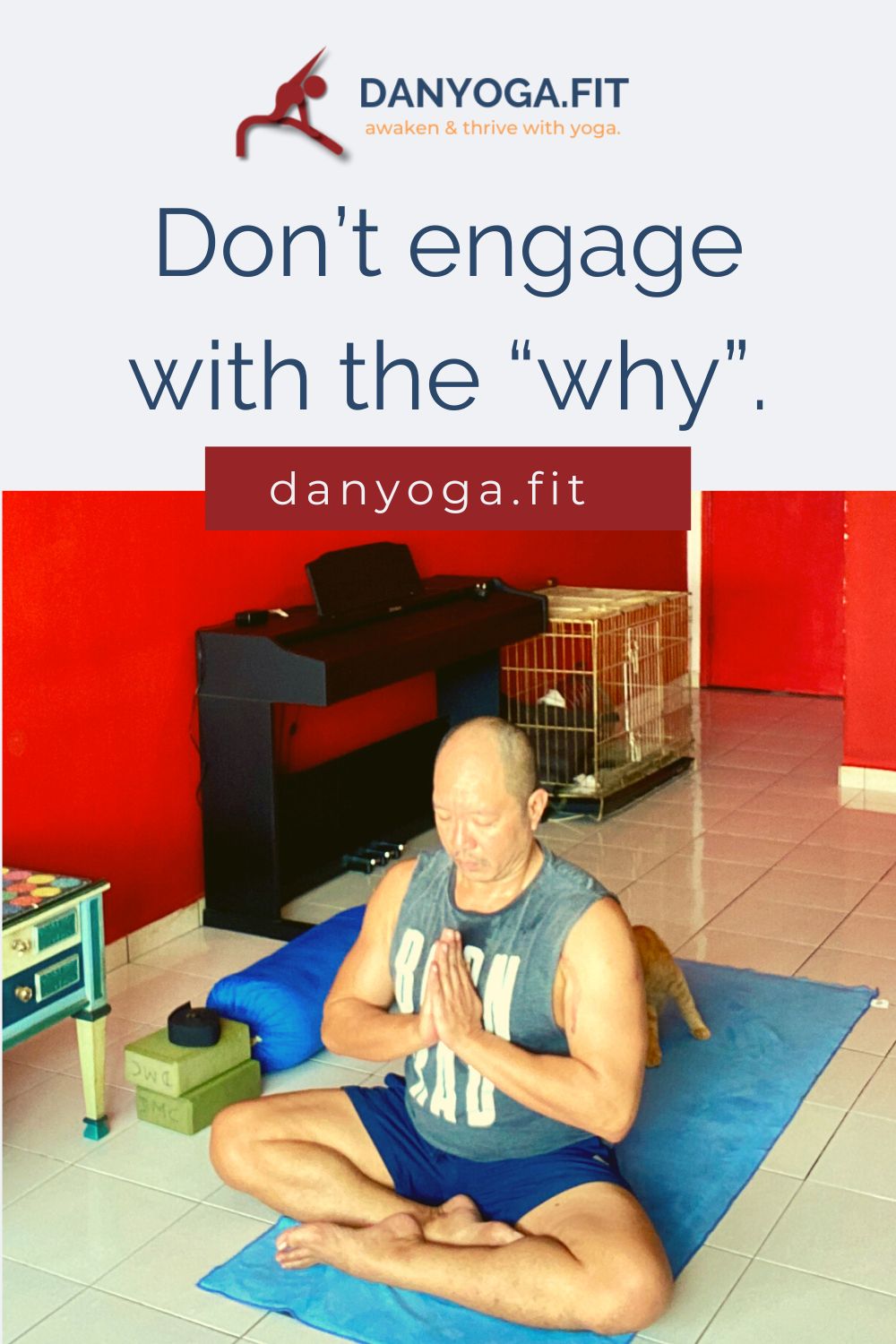Meditation, yoga and mindfulness practices can yield so much benefit for us. Meditation in particular is scientifically proven to:
- Reduces stress
- Controls anxiety
- Promotes emotional health
- Enhances self-awareness
- Lengthens attention span
- May reduce age-related memory loss
- Can generate kindness
- May help fight addictions.
- Improves sleep
- Helps control pain (I wrote about this, read more here!)
- Can decrease blood pressure

All these benefits won’t come to us if we engage with the ‘why’s of what comes up. In fact, our job isn’t to engage at all with what arises. Our job is to observe, not critically evaluate. Our goal is to be the seer, not the doer.
What this means is we can ask ‘what’, ‘where’ and ‘how’ questions (if we want to ask questions at all in the first place!), but we leave the ‘why” and ‘how come’ for journaling or for mindful reflection.
Let’s look at a concrete example.
Two sides to the story.
My father passed away in late October. It is as if the universe (God, or the Divine – whichever word you’d like to use) wanted to prepare me, as I spent a lot of time with Buddhist and Eastern Christian philosophy prior to his hospitalisation and departure.
What I learnt – or rather what was highlighted – was that there is always two sides (or more) to any story.. Focusing on the ‘why’ of the matter, ‘why did he die?’ or ‘why did he suffer’, would not highlight this fact.
Grief is the flip-side of joy. Without grief, joy could not exist. Interestingly, as my father lay in hospital, he told my aunts that notwithstanding all his physical suffering, he had never felt such joy. This is just an example.
During his hospitalisation and death, there was so much support for him and us, his family, that there were moments that a deep welling of joy arose in my heart, notwithstanding my grief.
And those weeks and days, even up to now, I notice how I have a joy that he gave me those memories and experiences, all of them, the good and the bad.
The flip-side of life is death. There can be no life without death, and of course no death can take place without a life beforehand.
Focusing on the ‘why’ – whether in meditation, yoga or mindfulness practice (in fact, it wouldn’t be ‘mindful’ if the ‘why’ was entertained) – does not lead to healing.
Some things just are.
Engaging with the ‘why’ of things actually takes us down the rabbit hole of avoidance. For example, if I had focused on ‘why did my father die’ or ‘why did he suffer the way he did’, I could begin speculating and just dive deep down into the rabbit hole of conjecture.
This is the same when we begin entertaining thoughts of ‘why do bad things happen to good people’ or ‘why do good things happen to bad people’. All kinds of unhelpful emotions for the moment will arise – indignation, anger, unhappiness.

While in some situations, such as social injustice, these emotions are very skilful in helping us move forward to aid in a better society. However, when it comes to healing ourselves through meditation, prayer, yoga and mindfulness practice, the conjecture and speculation just helps us avoid our wounds or grief.
Some things just are.
The question is – can we accept that?
What to do instead.
When we sit down to meditate, or when we roll out our mat, or if we decide to go for a mindful walk, we should observe. Questions – if they do arise – would be of the ‘what’, ‘how’ or ‘where’ nature. For example:
- What am I feeling?
- Where do I feel it in my body?
- How does it feel? How does it make my breath?
Questions of the ‘why’ nature should be left aside for reflection or journaling.
Read more on mindfulness below:
If you have any questions, or would like to dig deeper with me, do contact me here.
Alternatively, check out the short Mindful Mornings Mini Course below!

The Mindful Mornings
mini course
If your days are fraught with stress and anxiety, this mini-course is for you!
It offers methods on how to incorporate mindfulness into your mornings and includes:
- An introductory video
- A guided meditation video
- A yoga movement practice video
- A video on examples of mindfulness routines you can incorporate into your mornings, AND
BONUS CONTENT:
- Mindful Mornings Modalities – four videos
- Yoga Wall Stretches for the low back – four videos
- A mindful morning pdf checklist
